MES/MOM Certificate of Awareness
Manufacturing Execution Systems are the fundamental enablers of Digital Transformation. To successfully improve your Manufacturing Operations, you need to invest in smart technology and digitalization and invest in your people. MES training, MOM training, MOM education, MES education – call it what you like, education plays a vital role in developing MES/MOM best practices.
The MES/MOM Methodologies Certificate of Awareness (CoA) is part of MESA International’s independent global education program developed for the global manufacturing community. This Awareness Certificate offers the essentials of the comprehensive Certificate of Competency program to provide an introduction into the world of Manufacturing Operations Management. We created the certificate to educate and build awareness of potential MES/MOM solutions, which are essential for advancing to Industry 4.0 and Smart Manufacturing. This education program shares best practices in industry standards ISA-95 and ISA-88; creating a solid business case; making the right MES/MOM selection for your manufacturing needs; and helping to transform your business to operational excellence with MES/MOM deployment.
Program Learning Objectives
- Explain why manufacturers are changing and how MOM plays a key role in accelerating change through scalable continuous improvement
- Develop knowledge and understanding of relevant industry standards, ISA-95 and ISA-88
- Understand the various MOM application types and their roles in an application landscape
- Know about existing (smart) manufacturing architectures
- Discuss the opportunities offered by Smart Manufacturing and Industry 4.0 technologies and methodologies
- Discuss the need for a Manufacturing Transformation Strategy
- Explain how a Manufacturing Capability Assessment provides guidelines for a structured step-by-step improvement
- Explain the importance of Manufacturing Master Data Management and its role in the New Product Development and Introduction process
- Develop a strong business case that identifies the key business elements to justify MOM and Smart Manufacturing projects
- Understand the process for MOM product selection and how to select the right MOM solution for your organization’s needs
- Discuss the different project methodologies and frameworks
- Explain the importance of user acceptance
Classroom and Online
Classroom: The program is taught in a classroom environment over two consecutive days.
Online: Instructor leads online version of the same program that is delivered in three, 5-hour sessions on three consecutive working days.
Certificate
An awareness test is administered for each course in the program. Learners must score 85% or higher on each test to receive the program’s Certificate of Awareness. There are two parts to the awareness test for each course:
- In-course test consisting of up to 11 questions answered as the course progresses
- Post-course test consisting of up to 11 questions answered within eight weeks after course completion
Completing a MESA-approved Certificate of Awareness (CoA) is recognized globally, showing industries you have achieved a high standard of education within the MES/MOM field. Over 1800 professionals are now MESA-approved MES/MOM certificate holders.
Courses in the MES/MOM* Methodologies Certificate of Awareness Program
Frequently Asked Questions
- Why do I need MES/MOM Awareness training?
Current industry discussions focus on the actual role of manufacturing/production in the global supply chain network. For any manufacturer to be competitive, actual manufacturing operations activities must be highly interactive in supply chain and enterprise processes to achieve effective collaboration and competition. This is the domain of collaborative and flexible manufacturing operations management (MOM) system architectures. Gaining awareness about preparation, selection and implementation of MES/MOM solutions is essential to capture the benefits. - Who benefits from attending?
Completing the CoA certificate is best for manufacturing/operations management and leaders, operations excellence/continuous improvement experts, systems analysts, architects and programmers who are relatively new in the MES/MOM domain. - What industries do people come from to attend this education program?
MESA’s Global Education Program is not industry specific. Participants come from all industries. If you prefer, you can host an in-house program tailored specifically to your industry. For more information, contact one of MESA's authorized training providers in your area. - Does this program lead to further education?
The Certificate of Awareness offers the essentials of the comprehensive Certificate of Competency program, which would be a potential next step.
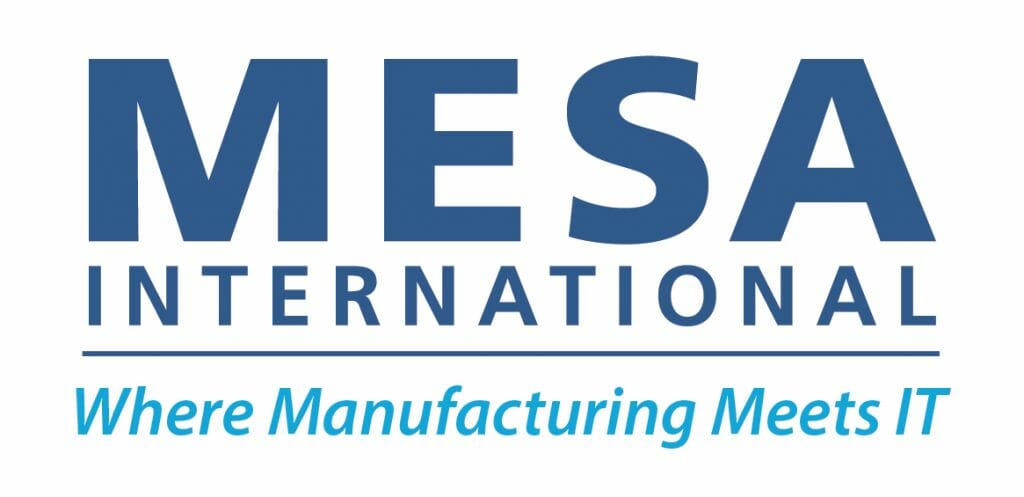

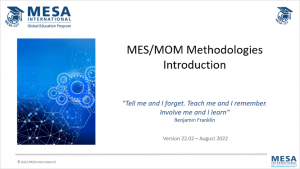 Times are challenging. The impact of the unexpected Covid-19 pandemic, the increasing dynamics of demand, supply chain issues and the “usual” operational challenges are having a significant impact in a manufacturer’s life.
Times are challenging. The impact of the unexpected Covid-19 pandemic, the increasing dynamics of demand, supply chain issues and the “usual” operational challenges are having a significant impact in a manufacturer’s life.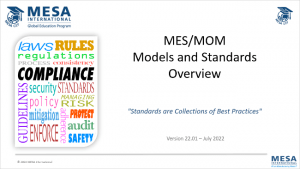 Current industry discussions focus on the actual role of manufacturing/production in the global supply chain network. For any manufacturer to be competitive, actual manufacturing operations activities must be highly interactive in supply chain and enterprise processes to achieve effective collaboration and competition. This is the domain of collaborative and flexible manufacturing operations management (MOM) system architectures.
Current industry discussions focus on the actual role of manufacturing/production in the global supply chain network. For any manufacturer to be competitive, actual manufacturing operations activities must be highly interactive in supply chain and enterprise processes to achieve effective collaboration and competition. This is the domain of collaborative and flexible manufacturing operations management (MOM) system architectures.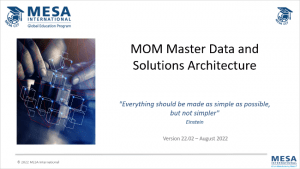 This course introduces and explains the various types of MOM solutions and their roles in the manufacturing operations systems landscape. Connectivity and integration between all manufacturing, business applications and more is increasingly important when facing the current challenges. To achieve this requires an enterprise application framework or information architecture.
This course introduces and explains the various types of MOM solutions and their roles in the manufacturing operations systems landscape. Connectivity and integration between all manufacturing, business applications and more is increasingly important when facing the current challenges. To achieve this requires an enterprise application framework or information architecture.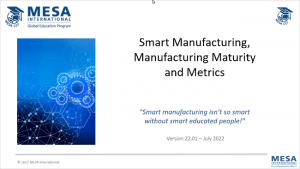 Smart Manufacturing is not just about technology. It is not something you buy off the shelf. Smart Manufacturing is primarily about empowering people in manufacturing. There are many things that make Smart Manufacturing attractive, like new business models, supply chain and partner collaboration, self-correcting manufacturing, real-time response and flexible (agile) production with standardized processes. In this course, we discuss its core concepts.
Smart Manufacturing is not just about technology. It is not something you buy off the shelf. Smart Manufacturing is primarily about empowering people in manufacturing. There are many things that make Smart Manufacturing attractive, like new business models, supply chain and partner collaboration, self-correcting manufacturing, real-time response and flexible (agile) production with standardized processes. In this course, we discuss its core concepts.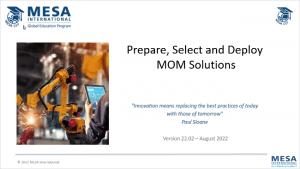 Based on discussions with industry leaders and domain experts, the course explains how to construct a compelling business plan with a defendable ROI business justification for MOM solutions. Explained are how to quantify the form of operations process, its inefficiencies, its solution alternatives/compromises, benefits and plant migration path. We will discuss explicit examples of successful justifications. The course arms learners with information needed to understand and address the competition (internal and external) for the scarce resources that exist for today’s manufacturers.
Based on discussions with industry leaders and domain experts, the course explains how to construct a compelling business plan with a defendable ROI business justification for MOM solutions. Explained are how to quantify the form of operations process, its inefficiencies, its solution alternatives/compromises, benefits and plant migration path. We will discuss explicit examples of successful justifications. The course arms learners with information needed to understand and address the competition (internal and external) for the scarce resources that exist for today’s manufacturers.